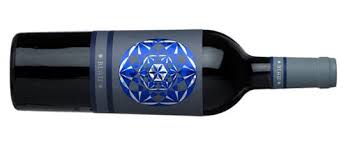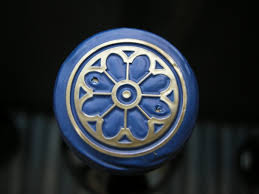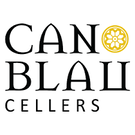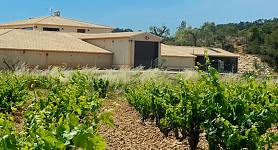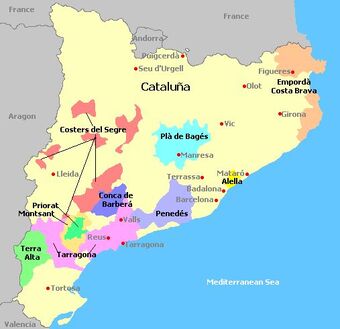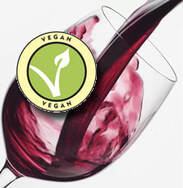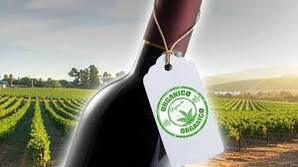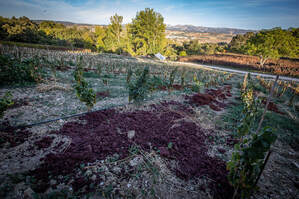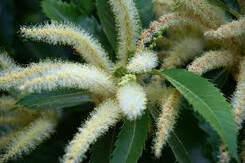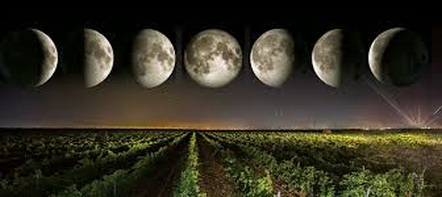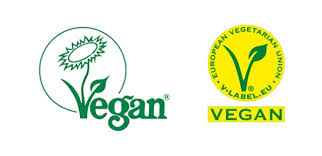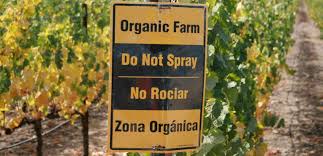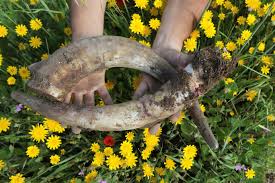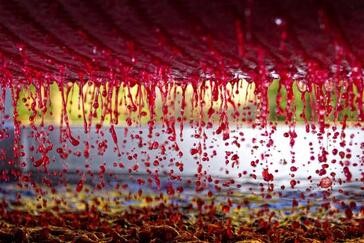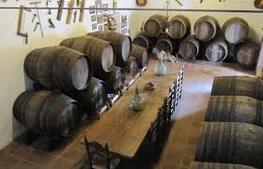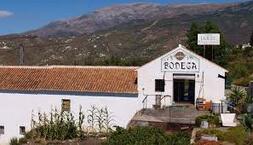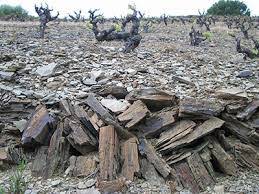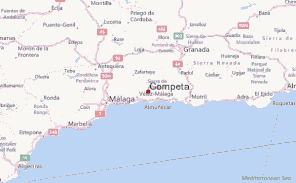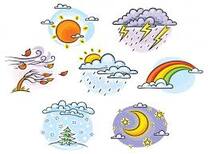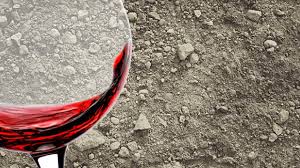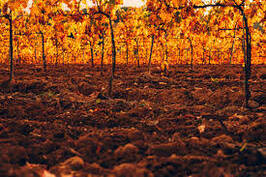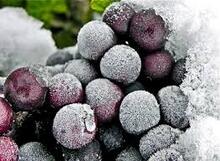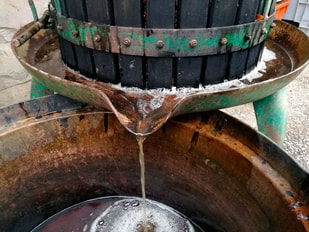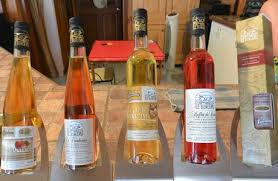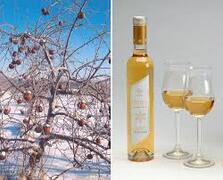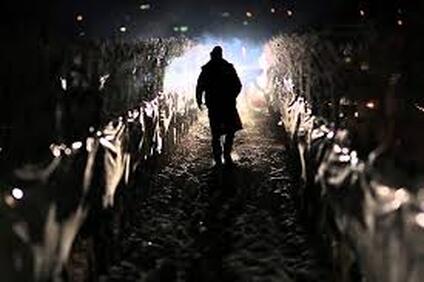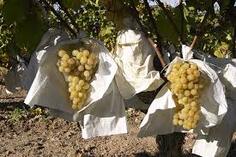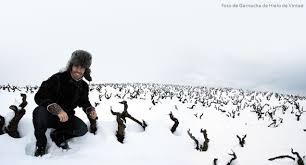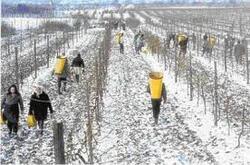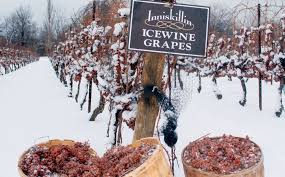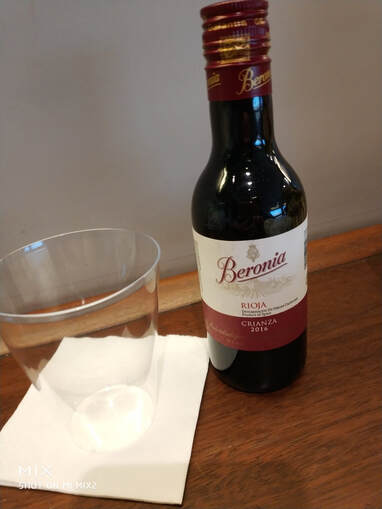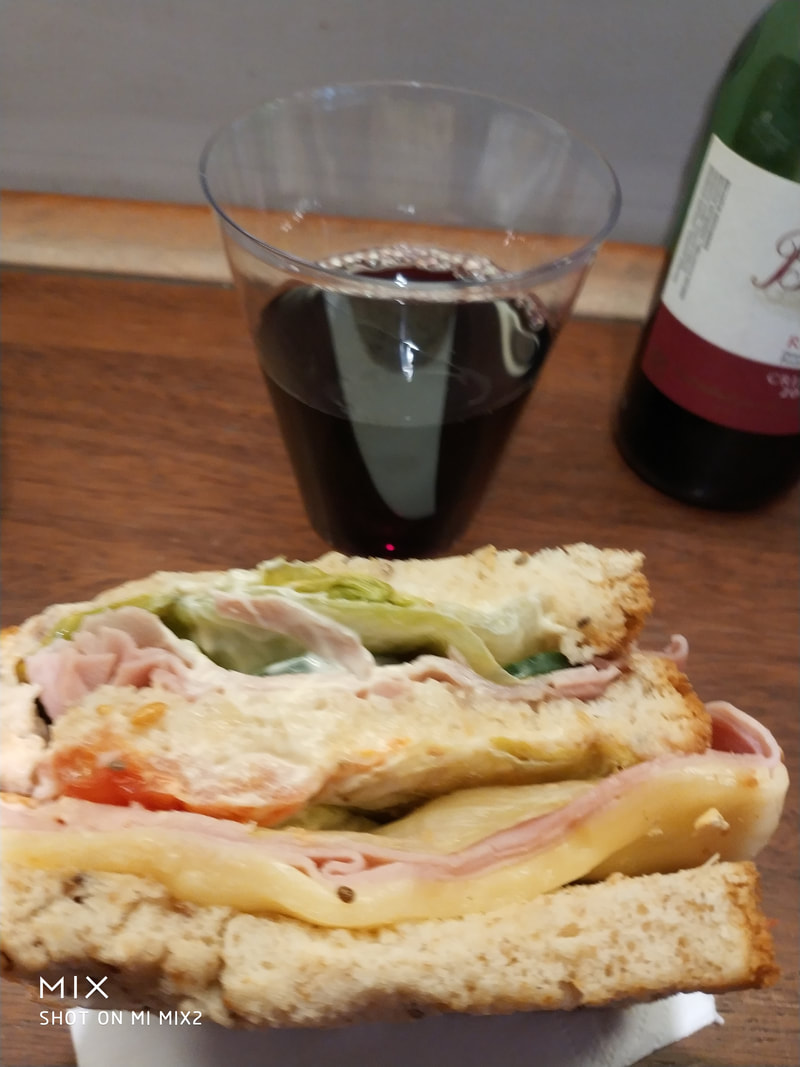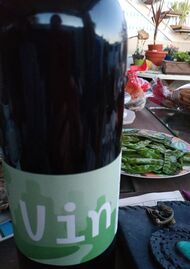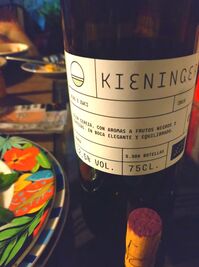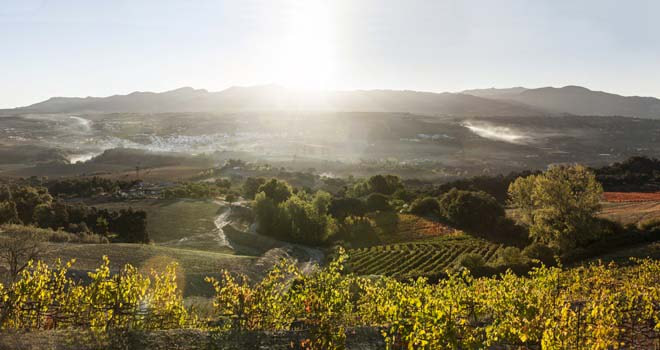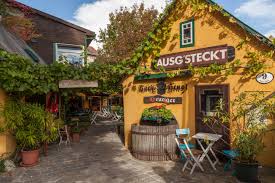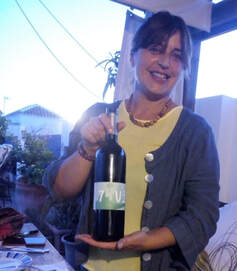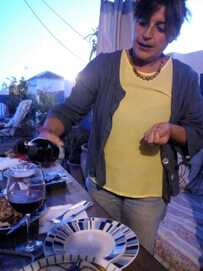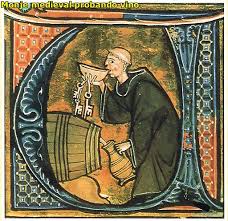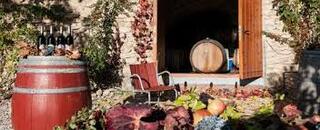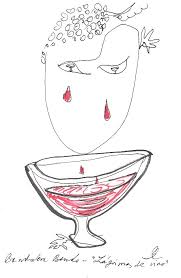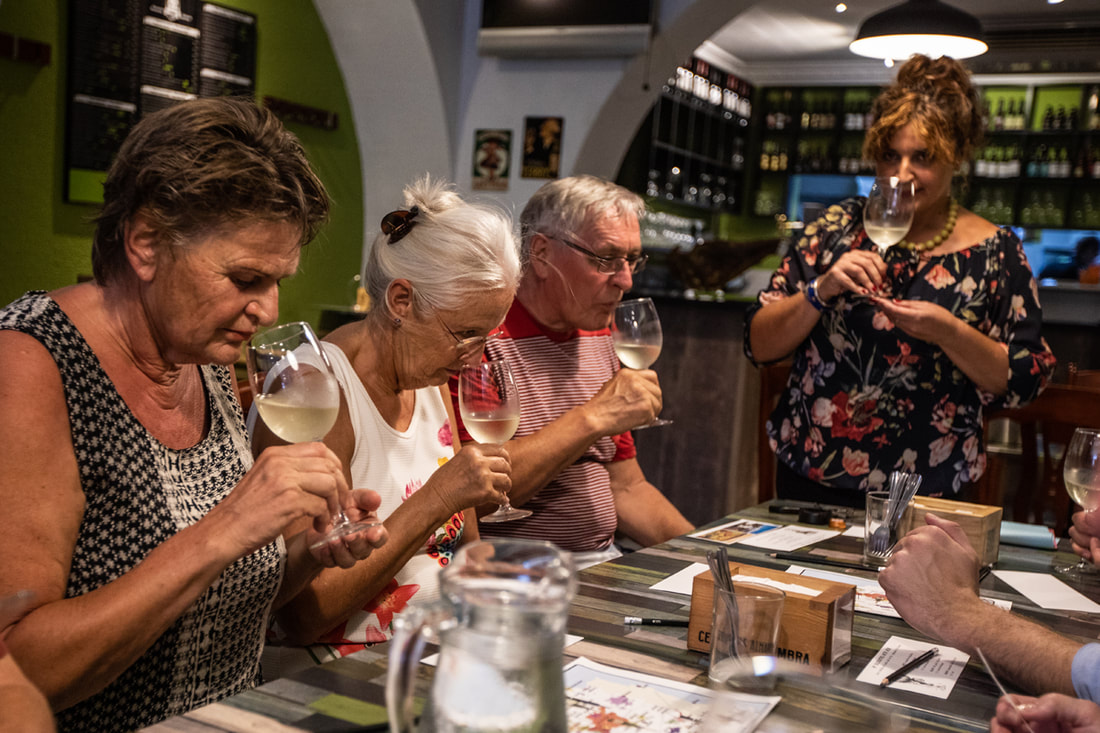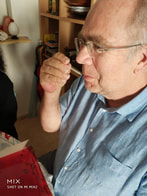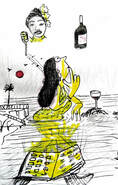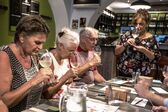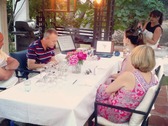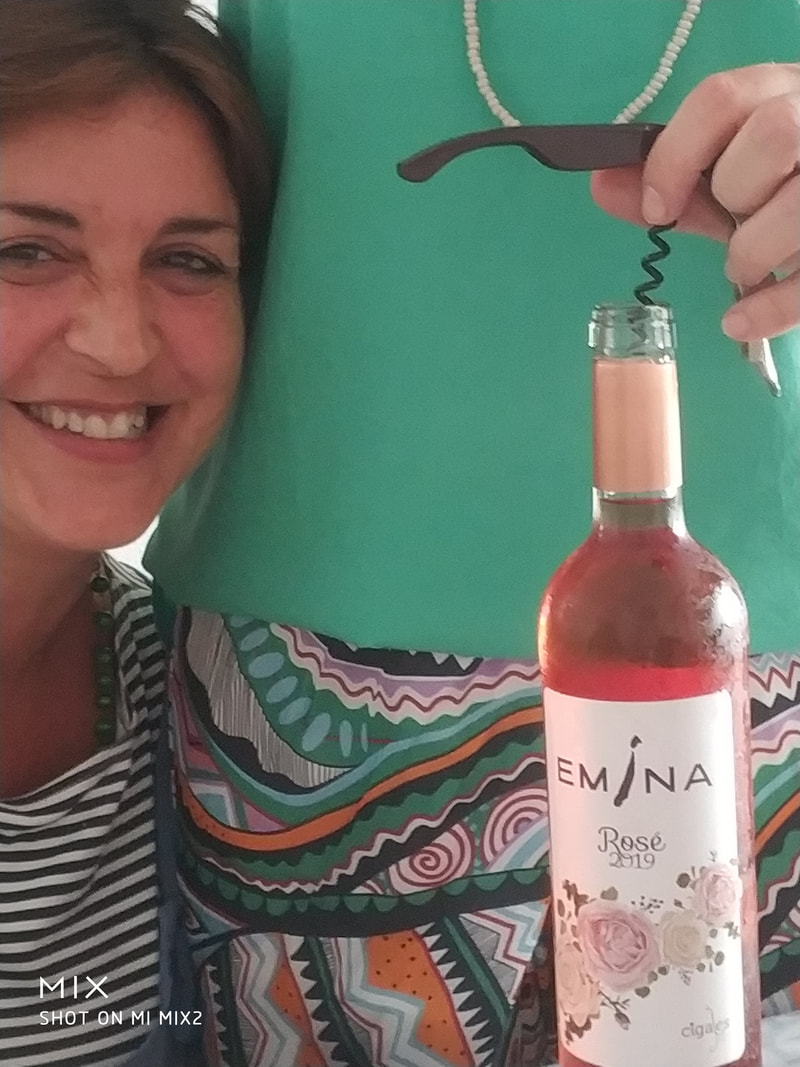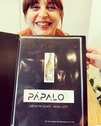|
BLAU Vino tinto Roble. 4 meses en barrica de roble francés. Variedad: Syrah, Cariñena, Garnacha Tinta D.O. Montsant. El Molar-Tarragona. Bodega Cellers Can Blau. Bodegas Familiares Juan Gil. Bodega Cellers Can Blau de Montsant forma parte de una de las siete bodegas que pertenecen al grupo Orowines. Caracterizándose al igual que el resto, de bodegas y viñedos propios donde lo que quieren mostrar es la personalidad de cada una de las zonas que representan a través de sus viñedos. Montsant, nombre de sierra y de parque natural, con sus viñas viejas de altura entre 200 a 700 metros sobre el nivel de mar. Este vino es una mezcla de uvas plantadas en diferentes tipos de suelos que se adaptan a cada variedad y se obtiene una magnifica diversidad. Por una parte tenemos la Cariñena (50%) plantada sobre suelos arcillosos, la Syrah (25%) plantada sobre suelos calizos y la Garnacha (25%) plantada sobre suelos de roca metamórfica conocida como licorella. El clima en esta zona es mediterráneo pero con una cierta continentalidad. Las montañas actúan como barrera natural ante la influencia marítima, hecho que provoca una gran oscilación térmica entre el día y la noche. En general, los inviernos son fríos y los veranos secos y calurosos. 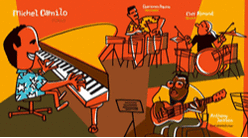 CATA: EN PALADAR : Mineral, intenso y equilibrado. EN NARIZ : Especiado, y de jugoso aroma a zarzamora. A LA VISTA : Un sugerente rojo picota con matices cárdenos. Puede maridar con casi todo, lo que se suele llamar vino todoterreno, pero unas de mis sugerencias sencillas ,a la par que resultonas podría ser con : Brocheta de pollo con pimientos verdes asados. Queso ahumado de oveja. Risotto de setas. Y musicalmente hablando, a mi parecer…Con un albúm de Michel Camilo, “Essence” lleno de energía y elegancia. Aunque también pensé en algún tema de Joan Manuel Serrat, ya que su fama y bodega en la zona es bastante mediática… Perinet Winery. Hay muchas formas de definir a un vino. Hay quien apela a los sentidos y hay quien asegura que cada vino es el resultado de la suma de la variedad, el factor humano y el territorio que viene marcado por el clima y la tierra, y en este caso, es perceptible. Un vino original y seductor que se desliza por los sentidos con carácter pero sin agresividad. Y con un potencial para disfrutarlo ahora o en uno o dos años. OBSERVACIONES Y CURIOSIDADES : Montsant es una denominación situada en la provincia de Tarragona, envolviendo a la denominación del Priorat. Es una denominación de origen joven, aunque está situada en una tierra con una larga historia de tradición vitivinícola. Una de las preguntas que con más frecuencia gira entorno a una cuestión que desde hace años genera un interesante debate: ¿Cuál es la diferencia principal entre los vinos de Montsant y Priorat? .Principalmente tintos elaborados con Garnacha y Cariñena, son vinos sinceros, salvajes, artesanos. Con una muy buena relación entre su gran calidad/ precio y sus cepas viejas, tintos aterciopelados son las señas de identidad comunes. .Por otro lado, mientras que los suelos pizarrosos predominan en el Priorat, y son en parte responsables de la enorme fama mundial que han cosechado estos vinos por su mineralidad única, en la D.O Montsant predominan las argilas y los terrenos calcáreos. 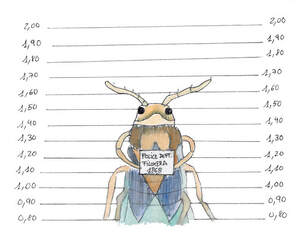 .Otro aspecto importante a tener en cuenta es la pluviometría, algo superior en la D.O Montsant, así como los rendimientos de las cepas, también ligeramente superiores en esa zona. Por este motivo, los vinos del Montsant podrían definirse, siempre en términos generales, como algo más frescos y con un fondo de fruta más marcado que los de la D.O Priorat, más concentrados y minerales. Del Priorato al Montsant y viceversa / La filoxera y el cooperativismo .El movimiento cooperativista surgió a principios del siglo pasado. Nació como respuesta a la necesidad de supervivencia, cuando la plaga de la filoxera acabó con una gran parte de los viñedos. En esta situación, el cooperativismo constituyó una de las pocas alternativas para seguir adelante. La cercanía de ambas zonas propicia el compartir e intercambiar experiencias. Muchos de los elaboradores del Priorato han comprado fincas y levantado bodegas en la D.O Montsant. Vinos por descubrir. Montsant está considerada por la prensa especializada como una valor en alza, y medios de comunicación prestigiosos como “The Wine Spectator” no dudan en calificarla como “un gran descubrimiento”. En este sentido es clave la calidad de sus vinos pero también su equilibrada relación calidad-precio. La prestigiosa guia de vinos española “Guia Peñin” afirma “la calidad de los vinos de Montsant y su buen precio convierten esta región en una excelente alternativa”.
1 Comentario
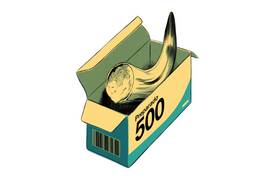 When a winery indicates that its wines are suitable for vegans it means that any animal derivative has been excluded from the manufacturing process, those that, since ancient times, have been used to clarify the wine, to eliminate solid waste that detract from transparency , which show them cloudy, and and that drinkers do not like, neither in sight, nor on the palate. Eradicate contamination in the wine sector. The law in Europe does not require that all wines exceeding 10mg / l should indicate on the label that they contain sulphites only for the sake of reporting, but that it is also necessary because a small percentage of the population is sensitive or allergic to sulphites. In general, organic and biodynamic wines contain sulphites for their conservation and evolution, although much less than conventional wines. The world of oenology is increasingly oriented towards the creation of biodynamic wines, replacing traditional artificial additives with others of natural origin, such as chestnut flower. Ozone in the wine industry can also make a great use. Throughout the winemaking process, from the care of the same vineyard to the washing of grapes, equipment and facilities. And also using only vineyard pruning wood, they can substitute sulphur dioxide in winemaking and preservation.. Definitions and curiosities about this wine classification : NATURAL WINES : The grapes to produce these wines are fermented without any intervention, only with indigenous yeasts (natural from the grape). The addition of sulphurous anhydride, or correction of acidity, sugar or clarification through the use of adjuvants is not allowed. Like biodynamic wines, they are also governed by a lunar, solar and astrological calendar. The wines called natural and I say called, since there is no legislation that sets standards in this regard, it is understood that they are those wines that have not used SO2 in their elaboration process and are exempt from this added product; since they can have a small amount of the sulphur treatments carried out in the field or that are naturally in the environment of the vineyards. In addition, in the wine labeling it is mandatory to announce that it "contains sulphites" if the amount is greater than or equal to 10mg / L. It is understood that if the amount is smaller, the label will not say anything about it, which does not mean that it does not contain it. These wines are usually wines without aging in the barrel, since not being protected against oxidation, the fact of being in the barrel would provide them with a significant increase in Volatile Acidity through the excessive proliferation in the barrel wine of the acetic bacteria Therefore, these wines have clear time limitations and are usually short and bottled wines. WINES WITHOUT ADDED SULPHITES: Sulphurous Anhydride or Sulfur Dioxide, is a chemical preservative that is added to many foods and beverages for maintenance. You can find it with other names such as: "sulphites", "SO2", or the famous "E220 to E228"; but they all refer to the same. In agriculture, sulfur has been used since ancient times to protect plants against fungi. In the cellar, sulphites are used primarily to disinfect. The sulphites can be added to the wine directly by adding sulphur to the vats or barrels. In Oenology: the application of sulphurous in oenology is limited to antimicrobial uses, acting against microbes such as molds, bacteria and negative yeasts; and to antioxidant uses, acting against oxidases that are enzymes that go in the grapes and that can deteriorate both the color and the taste of the wine. Organic wines can carry up to 75mg / L of SO2, it is more than enough for proper preservation if the grapes that were put in the cellar were of quality and had a correct sanitary status; as would correspond to an organic grape of authentic quality. In conclusion, unless you have an allergy or sensitivity to sulphur, you should not worry about a wine that "contains sulphites", rather we should worry about a wine that does not contain them. VEGAN WINES: The wines suitable for Vegans (Vegan-friendly wines) are those in which no materials of animal origin are used during clarification, but in addition, most vegan wines tend to come from organic vineyards, that is, from vines that have not been treated with fertilizer or artificial chemical pesticides. Currently there is no specific legislation in Spain that indicates the requirements that a vegan wine must meet to be certified as such. What vegan winemakers try to do is certify their bottles by independent agencies such as the Spanish Vegetarian Union, which certifies with a European v-lebel seal. These seals only certify that during the winemaking process, neither parts of animals nor their derivatives have been used. The only regulation, common to all wines, is the one that requires to indicate on the label that the wine contains sulphites if the amount is greater than 10mg / L. Many of the vegan wine producers choose not to add more sulphites to their broths to avoid losing qualities. It must be taken into account that during the fermentation of the wine, sulphurous substances is produced naturally and in small quantities, the so-called endogenous sulphites. There are producers who believe that no more sulphites should be added for the preservation of the wine, giving rise to the so-called "sulphite-free wines". ORGANIC WINES: They lack aggressive and invasive practices from the vineyard, in which herbicides, pesticides and fertilizers or any industrial toxic product are prohibited. Only supplies for disease prevention are used and these must be allowed by the certifiers, which are the ones that determine if the requirements necessary to qualify as a final organic product are met. Definitions and curiosities about this wine classification : BIODYNAMIC WINES: The origin of these wines is found in the Anthroposophy of Rudolf Steiner, a science that combines medicine, homeopathy and astrology. It is essential that, for a wine or vineyard to be biodynamic, it is first governed by organic practices. Therefore, the use of pesticides or any other chemical element in the vines is not allowed. The work of harvest, cellar and even tastings, are guided through a lunar and astrological calendar. The worldwide certification that governs these wines is called Demeter. Steiner prescribed nine different biodynamic preparations to help fertilization. They are the cornerstone of biodynamic agriculture and he described them exactly how they should be prepared: - cowhorn filled with ground milled quartz. It is buried in spring and taken out in autumn. It can be mixed (mixing a tablespoon of quartz powder in 250 liters of water). The mixture is sprayed at low pressure on the crop during the rainy season, to prevent fungal diseases. It should be sprayed on a cloudy day or first thing in the morning to prevent the leaves from burning. Si te interesa el título de este artículo, quizás es porque ya has probado a comparar algún vino ecológico con otro convencional, o tienes curiosidad al respecto y no tienes claro lo que les diferencia…Voy a intentar aclarar conceptos lo más sencillamente y resumido posible. Si observamos las etiquetas de los alimentos que nos rodean últimamente, podemos descubrir que el veganismo está tomando auge, pero sobe todo cuestiones más importantes y filosóficas como un estilo de vida,cuidando el medio ambiente y una tendencia a saber qué es lo que incorporamos a nuestro cuerpo al alimentarnos. En algunos casos es por razón de alergias concretas e intolerancias. Nos plantea dudas como cúal puede ser la relación del vino, algo supuestamente vegetal con los animales…? Cuando una bodega indica que sus vinos son aptos para veganos se refiere a que se ha excluido del proceso de elaboración cualquier derivado animal, esos que desde la antigüedad, se han empleado para clarificar el vino, para eliminar los residuos sólidos que le restan transparencia, que los muestran turbios, y que no gustan a los bebedores ni a la vista ni al paladar. El mayor ejemplo lo tenemos en el gel de proteína que es la clara de huevo. Se echa en el líquido y, poco a poco, por tiempo y por temperatura, va coagulando y atrapando todas las impurezas, hasta que, según los casos, flota como una capa esponjosa en la superficie o se deposita en el fondo dejando pulcro y brillante el líquido, el caldo o, en este caso, el vino. Para clarificar un depósito hacen falta muchos miles de claras, por eso se fueron sustituyen por otros limpiadores, algunos también animales como la caseína (de leche) o la gelatina de huesos o de cola de pescado. Para sustituirlas ,se pueden y se suelen emplear otros clarificantes minerales con excelentes resultados. La bentonita, carbón activado, gel sílica o un polímero de nombre tan largo que se ha reducido como PVPP. Los clarificantes, en cualquier caso, se eliminan con el tiempo y el reposo, tanto en los depósitos como, más aún, en la crianza en barricas, pero con estos clarificantes minerales la seguridad de que no hay memoria animal es total. Por cierto, los no veganos se preguntarán qué se hace con tantos miles de yemas sobrantes. No hay más que mirar al mapa de las mayores zonas vitivinícolas de este país. La repostería conventual de nombres celestiales, las yemas de todos los santos y los tocinos de todos los cielos se han nutrido de las yemas que les regalaban las bodegas. Quizá con un poco de interés, para que pidieran a los patronos celestiales de la meteorología lluvias y soles en su momento, un buen año para el vino. 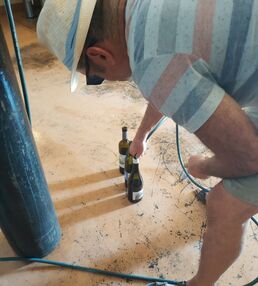 Erradicar contaminaciones en en el sector vinícola. La ley en Europa no obliga a que todos los vinos que superen los 10mg/l deban indicar en la etiqueta que contienen sulfitos solo por el hecho de informar, sino que también es necesario porque un pequeño porcentaje de la población es sensible o alérgico a los sulfitos. En general, los vinos ecológicos, orgánicos y biodinámicos contienen sulfitos para su conservación y evolución, aunque muchos menos que los vinos convencionales. El mundo de la enología está cada vez más orientado hacia la creación de vinos biodinámicos, sustituyendo los tradicionales aditivos artificiales por otros de origen natural, como es el caso de la flor de castaño. También el ozono en la industria vitivinícola puede sacar un gran partido. A lo largo del proceso de elaboración de los vinos, desde el cuidado de la misma viña hasta el lavado de las uvas, equipos e instalaciones. Y también empleando únicamente madera de poda de la viña pueden sustituir al dióxido de azufre en la elaboración y conservación del vino. Definiciones y curiosidades acerca de esta clasificación de vinos : Vinos Naturales: Las uvas para producir estos vinos son fermentadas sin ningún tipo de intervención, sólo con levaduras indígenas (naturales de la uva). No se permite la adición de anhídrido sulfuroso, ni corrección de acidez, azúcar o clarificación mediante el uso de coadyuvantes. Al igual que los vinos biodinámicos, también se rigen por un calendario lunar, solar y astrológico. Los vinos llamados naturales y digo llamados, ya que no existe una legislación que marque unas normas al respecto, se entiende que son aquellos vinos que no han utilizado SO2 en su proceso de elaboración y están exentos de este producto añadido; ya que sí pueden tener una pequeña cantidad de los tratamientos con azufre realizados en el campo o que de forma natural hay en el ambiente de los viñedos. Además, en el etiquetado del vino es obligatorio anunciar que “contiene sulfitos” si la cantidad es mayor o igual a 10mg/L. Por lo que se entiende que si la cantidad es menor, la etiqueta no dirá nada al respecto, lo cual tampoco quiere decir que no lo contenga. Estos vinos suelen ser vinos sin crianza en barrica, ya que al no estar protegidos contra la oxidación, el hecho de estar en la barrica les proporcionaría una importante elevación de la Acidez Volátil a través de la excesiva proliferación en el vino de la barrica de las bacterias acéticas. Por eso, estos vinos tienen unas limitaciones claras de tiempo y suelen ser vinos de evolución corta y en botella. Vinos sin sulfitos añadidos: El Anhídrido de Sulfuroso o Dióxido de Azufre, es un conservante de origen químico que se añade a muchísimos alimentos y bebidas para su mantenimiento. Puedes encontrarlo con otros nombres como: “sulfitos”, “SO2”, o las famosas “E220 a E228”; pero todos ellos se refieren a lo mismo. En agricultura, desde tiempos remotos se usa el azufre para proteger las plantas contra hongos. En Bodega se utilizan los sulfitos principalmente para desinfectar. La adición de los sulfitos al vino se puede realizar directamente añadiendo azufre a las cubas o barricas. En Enología: la aplicación del sulfuroso en enología se limita a usos antimicrobianos, actuando contra microbios como mohos, bacterias y levaduras negativas; y a usos antioxidativos, actuando contra oxidasas que son enzimas que van en las uvas y que pueden deteriorar tanto el color como el sabor del vino. los vinos ecológicos pueden llevar hasta 75mg/L de SO2, es más que suficiente para una correcta conservación si la uva que se metió en la bodega era de calidad y tenía un estado sanitario correcto; como correspondería a una uva ecológica de auténtica calidad. En conclusión, a menos que tengas una alergia o sensibilidad al azufre, no debes preocuparte por un vino que «contiene sulfitos», más bien debería preocuparnos un vino que no los contenga. Vinos Veganos: Los vinos aptos para Veganos son aquellos en los que no se utilizan materias de origen animal durante la clarificación, pero además, la mayoría de vinos veganos suelen proceder de cultivos de viñas ecológicas, esto es, de viñas que no han sido tratadas con abono o plaguicidas químicos artificiales.. Actualmente no existe legislación específica en España que indique cuáles son los requisitos que debe cumplir un vino vegano para ser certificado como tal. Lo que tratan de hacer los viticultores de vinos veganos es certificar sus botellas por medios de organismos independientes como la Unión Vegetariana Española, que certifica con un sello europeo v-lebel. Estos sellos certifican únicamente que durante el proceso de fabricación de los vinos no se han utilizado ni partes de animales, ni derivados de los mismos. La única normativa, común a todos los vinos, es la que obliga a señalar en la etiqueta que el vino contiene sulfitos si la cantidad es superior a 10mg/L. Mucho de los productores de vinos veganos eligen no añadir más sulfitos a sus caldos para evitar la pérdida de cualidades. Hay que tener en cuenta que durante la fermentación del vino se produce sulfurosos de manera natural y en pequeñas cantidades, los llamados sulfitos endógenos. Hay productores que consideran que no se deben de añadir más sulfitos para la conservación del vino dando lugar a los llamados ¨vinos sin sulfitos ¨. 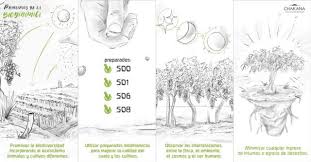 Vinos Orgánicos : Carecen de prácticas agresivas e invasivas desde el viñedo, en los cuales herbicidas, pesticidas y fertilizantes o cualquier producto tóxico industrial están prohibidos. Solamente se emplean insumos para la prevención de enfermedades y éstos deben estar permitidos por las certificadoras, que son las que determinan si se cumplen con los requisitos necesarios para calificar como producto orgánico final. Vinos Biodinámicos: El origen de estos vinos se encuentra en la Antroposofía de Rudolf Steiner, ciencia que combina la medicina, la homeopatía y la astrología.Es fundamental que, para que un vino o viñedo sea biodinámico, primero se rija por prácticas orgánicas. Por lo tanto, el uso de pesticidas o cualquier otro elemento químico en las vides no está permitido. Los trabajos de cosecha, bodega y hasta degustaciones, son guiados a través de un calendario lunar y astrológico.La certificadora a nivel mundial que rige estos vinos se llama Demeter. Steiner prescribió nueve preparados biodinámicos diferentes para ayudar a la fertilización. Son la piedra angular de la agricultura biodinámica y los describió exactamente cómo debían ser preparados: - Cuerno de vaca relleno de cuarzo molido en polvo. Se entierra en primavera y se saca en otoño. Se puede mezclar (mezcla de una cucharada de polvo de cuarzo en 250 litros de agua). La mezcla se rocía a baja presión sobre el cultivo durante la temporada lluviosa, para prevenir enfermedades por hongos. Se debe rociar en un día nublado o a primera hora de la mañana para evitar que las hojas se quemen. BODEGAS ALMIJARA S.L. CÓMPETA- Málaga -DENOMINACIÓN DE ORIGEN: “SIERRAS DE MÁLAGA” VARIEDAD: 100% Romé La Romé es una variedad de uva tinta propia de Andalucía, autóctona de la zona de Málaga. Su cultivo se da principalmente en la comarca de la Axarquía. UVA SECRETA, POCO CONOCIDA Y MISTERIOSA Cómpeta, en plena Axarquía malagueña, se encuentra situada a unos 636 metros de altitud sobre el nivel del mar, y en las faldas de las Sierras Almijara y Tejeda que constituyen un impresionante macizo montañoso, formando barrera geográfica entre las provincias de Málaga y Granada mediante su línea de cumbres, entre las que se encuentra, “la Maroma”, con 2.068 metros de altura. En este espectacular enclave, encuentra su ubicación Bodegas Almijara, pequeña, familiar y tradicional bodega con mucho encanto. Jarel es un vino que proviene de una uva tinta autóctona de los suelos pizarrosos de la Axarquía malagueña. Destacan su mineralidad y frescura, naturaleza. En boca es aterciopelado, sabroso y seco. Un vino sutil y armonioso, con recuerdos salinos y ancestrales en el postgusto. CATA: Tiene buena graduación alcohólica propia de las maduraciones en climas cálidos, y baja acidez. Notas vegetales, yodo y esquisto en nariz. Expresivo y franco en paladar. Su color me recuerda a ese toque rojo-naranja de las salsas agri-dulces , limpio y brillante. Marida muy bien con carnes y chacinas ahumadas. Y musicalmente hablando…me decidí por un tema precioso y evocador con solo flauta travesera, “Zyriab” de Jorge Pardo. Sin duda es un vino muy especial, particular, diferente, con personalidad y matices muy diferentes a cualquier rosado que estemos acostumbrados …O te enamora después del segundo sorbo o no llegas a conectar con él…Un placer poder deleitar este insólito vino, de muy poca producción , no disponible cada añada y solo para gente de exquisito paladar y con ese sentido para apreciar su esencia. Gracias María Ávila por reservar unas botellas para mí! Sus racimos son medianos y poco compactos, con pequeñas uvas redondas de color granate. Una de las peculiaridades de esta uva de piel gruesa es que en un mismo racimo se pueden encontrar uvas blancas, rosas y tintas. La Romé es una uva con poca materia colorante, que aguanta mucho el calor, de la que se saca un vino excelente con un sabor muy peculiar. Resurge la Romé, que es mucho menos conocida que la uva moscatel pero con la expresividad que tienen las uvas malagueñas. Actualmente sólo un par de bodegas de la Axarquía trabajan con esta variedad autóctona cuyos viñedos apenas se pueden ver en algunas parcelas de la Alta Axarquía y de Ronda. Antiguamente se usaban para dar color a los dulces, pero tiene cualidades suficientes para servir de base de los tintos. UN POQUITO DE HISTORIA: El primer testimonio histórico que conocemos de la elaboración de vino en Málaga, data del Bajo Imperio Romano y consiste en depósito prismático de fermentación descubierto en Cártama, a unos treinta kilómetros de la capital. Durante la dominación árabe se entabló una dura lucha entre las normas coránicas que prohibían el consumo de vino y la costumbre de beberlo, que había arraigado en nuestro pueblo. Poco a poco y con altibajos, los fuertes castigos -hasta pena de muerte para los borrachos- se sustituyeron por multas (garima), que progresivamente se transformaron en impuestos (qabäla), que debían pagar los vendedores de vinos y que llegaron a constituir uno de los recursos más importantes del Estado. En el siglo XIX la plaga de Filoxera acabó con las viñas que a día de hoy vuelven a tomar posiciones gracias a viticultores que han apostado por los vinos axárquicos extraídos de los suelos pizarrosos de la comarca. Su uso será la única forma de que no desaparezca. Si no se utiliza para elaborar vinos, los agricultores acabarán por no plantar viñas nuevas de esta variedad “En el momento en que tiene un fin aseguramos que no se extinga”. 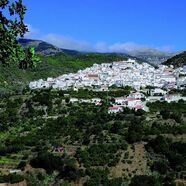 JAREL ROSÉ BODEGAS ALMIJARA S.L. CÓMPETA- Málaga - DENOMINATION OF ORIGEN: “SIERRAS DE MÁLAGA” GRAPE: 100% Romé Romé is a variety of red grapes from Andalusia, native to the area of Malaga. Its cultivation occurs mainly in the region of Axarquía. SECRET, LITTLE KNOWN AND MYSTERIOUS GRAPE Cómpeta, in the middle of Malaga's Axarquía, is located at about 636 meters above sea level, and on the slopes of the Sierras Almijara and Tejeda that constitute an impressive mountain range, forming a geographical barrier between the provinces of Malaga and Granada through its line of summits, among which is "La Maroma", with 2,068 meters high. In this spectacular enclave, Bodegas Almijara is located, family-run, small, and traditional winery with lots of charm. 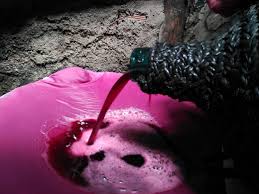 Jarel is a wine that comes from an indigenous red grape from the slate soils of the Malaga Axarquia. They emphasize its minerality and freshness, with hints of fresh , wild nature touch. In the mouth it is velvety, tasty and dry. A subtle and harmonious wine, with saline and ancestral memories in the aftertaste. TASTING : Good alcoholic graduation typical of ripening in hot climates, and are usually accompanied by low acidity. Vegetable notes, o Vegetable notes, iodine and shale on the nose . Expressive and candid on the palate. It has little colour but a lot of strength in the mouth. Its color reminds me of that red-orange touch of sweet and sour sauces, clean and bright. It pairs very well with smoked meats and especially with beef jerky. And musically speaking ... I decided on a beautiful and evocative song with only a transverse flute, "Zyriab" by Jorge Pardo. 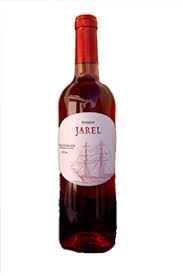 Undoubtedly it is a very special, particular, different wine, with personality and nuances very different from any rosé we are accustomed to ... Either you fall in love after the second sip or do not get to connect with it ... A pleasure to delight this unusual wine, of very little production, not available every vintage and only for people with exquisite palate and with that sense to appreciate its essence. Thank you Maria Ávila for reserving some bottles for me! A grape that withstands a lot of heat, from which an excellent wine is extracted with a very peculiar flavour. Its clusters are medium and not very compact, with small round garnet-coloured grapes. One of the peculiarities of this thick-skinned grape is that in the same cluster you can find white, pink and red grapes. Romé is a grape with little colouring matter. Much less known than the Muscat grape but with the same expressiveness. Currently only a couple of wineries in the Axarquía work with this native variety whose vineyards can barely be seen in some plots of the High Axarquía and Ronda. Formerly it was used to give color and character to sweet wines. A little history... The first historical testimony we know of the winemaking in Malaga, dates from the Lower Roman Empire and consists of a prismatic fermentation tank discovered in Cártama, about thirty kilometers from the capital. During the Arab domination a hard fight began between the Corán rules that prohibited the consumption of wine and the habit of drinking it, which had taken root in our town. Gradually and with ups and downs, the heavy punishments - even the death penalty for drunkards - were replaced by fines (garima), which gradually became taxes (qabäla), which the wine sellers had to pay and which became one of the most important resources of the State. In the nineteenth century, Phylloxera plague, ended the vineyards that are now taking positions again thanks to winemakers who have opted for Axarquía wines extracted from the slate soils of the region. Its use will be the only way it does not disappear. If it is not used to make broths, the farmers will end up not planting new vines of this variety "At the time it has a purpose we ensure that it does not die out" 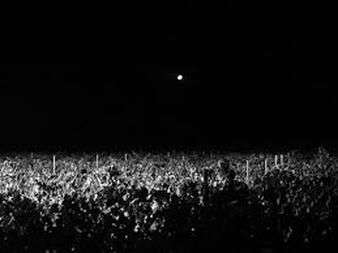 In the small Canadian city of Beamsville, about 40 miles west of Niagara Falls, a small group of crouching silhouettes moves in a moonligth vineyard on a cold January night. They are picking up their harvest of grapes, totally frozen, from Gewürztraminer. With a starry sky, and ice crystals shining in the air, the temperature has fallen to -10º C: they are the ideal conditions for the collection of fruit with which the 'icewine' will be made, the ice wine of this vintage. " It is likely that on some occasion you have heard of ice wine. That is why I am going to dedicate this article to this unique product, explaining its origin, evolution and, above all, the difference between ice wine and "freezer" wine. At the beginning of the 18th century, when Louis XV offered Madame de Pompadour a glass of Tokaj sweet wine, the monarch referred to it as “ Kings wine, king of wines ” and the poor did not have time to taste it ... If so, I would have had serious doubts and competition with this ice elixir. The wine of ice, scarce, rare, special, little known, the eiswein, is one of those magical wines ... It is a sweet wine made with naturally frozen grapes in the vineyard. The time and conditions of their harvest as well as the areas where they are obtained is what makes it special. There are white, rosé, red and even ice cider. They are tasty wines, with deep and sweet aromas, but soft and with an intense acidity. Named in English ice wine and in French vin de glace, it uses the technique of over-ripening of the grape in the strain until frost occurs. 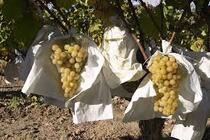 The grapes with which they are made are generally white, such as Riesling, Vidal (hybrid) banned in Europe, but popular in Canada - or Gewürztraminer, although there are also inks, such as Pinot Noir or Cabernet Sauvignon. Ice wines do not depend on a specific grape variety, but on a type of viticulture and winemaking. The grapes must be harvested by hand in a frozen state in the cluster and pressed with the ice crystals, which causes a high concentration of sugars and acids due to dehydration, thereby improving the extraction of aromatic compounds. At the beginning of August the grape is selected and the clusters are even put in paper bags (similar to those of the Vinalopó grape) to preserve them and ripen more slowly since the sun does not affect so directly. It is a wine that always works with the uncertainty of whether it will freeze enough to be able to harvest since it is necessary to obtain a concentrated, very ripe grape that will take time to ferment. On the other hand, this type of wine is obtained in cold regions of countries with low temperatures. Ice wines are made in Canada - which is the world's largest producer -, United States, Germany, Austria, Switzerland and Luxembourg. In Spain, ice wines have been successfully produced in Rueda, with the Verdejo variety, in La Rioja, Palencia ... among others, with Tempranillo and Garnacha red varieties. Currently, the European Union recognizes that an ice wine can be considered that way when they use frozen grapes or that they were in the strain at the time of harvesting and pressing. It is required that all grapes come from the same recognized region. Its difficulty and shortage, because not all producers are willing to make this type of wine and that there must be very specific climatic conditions (not every year it is possible to make these wines), justify its high market price, which They have turned this type of wine into authentic "oenological jewels," according to many authors. The 'cryo extraction' or cold extraction, is a process by which grapes are artificially frozen and pressed, usually with the intention of making ice wines artificially. Through this system, sweet or semi-sweet white wines are obtained, although this system is increasingly used in the production of dry and aromatic white wines. The winemakers try to recreate the same natural conditions that occur in the production of authentic ice wines. Selected grapes are subjected to temperatures below zero (-6 ° or -7 ° C), to be pressed when they are still frozen. Although it is a widely used winemaking technique that results in very interesting wines, the European Union does not allow them to be called "ice wines" since the grapes have been frozen by artificial methods. Curiously there is also "Ice Cider." In Spain the Asturian is famous and refers, for example, to what happened to the Germans with the grape to make wine or to the Canadians, who were frozen apples to make cider waiting for a ripening conducive to a high sugar content and / or alcohol. Of necessity, virtue: pressing the frozen fruit loses water and the must is more concentrated. The procedure was already applied by some cider maker in Asturias and the Denomination of Origen admitted it not long ago. Then, it has been incorporated by the brand El Gaitero, willing to standardize the renewal of that product beyond its crammed cider, and the result is called 1898, which is the year to which its winery goes back. This Asturian ice cider is a fruity ripe and sweet elixir, but the notes of lemon or tangerine, along with those of roasted apple— and a fresh acidity make it not cloying. Spend three months in barrel. What do we drink it with? It is a wine that is enjoyed a lot by itself, slowly, with kisses, as I like to call it to me, conversing with it slowly and with attention. Especially Canadians are very easy to enjoy, expressive and frank wines from the start. Germans usually need a little more time, both from bottle aging and freshly served by the glass. Some German ice wines appreciate even the decantation. I like it as an appetizer, since high acidity makes us salivate and saliva prepares the stomach for digestion. Great with any type of foie gras, hot or cold, and wonderful with almost any type of cheese, although maybe a little less with goat's. If we accompany it with desserts, the ideal is that the dessert is not sweeter than the wine, so great with any type of fruit. With dark chocolate, better red ice wines (although generally they are pink in sight). For the more daring, they work very well with pickles: the Vidal grape with orange duck and with some spicy Asian food, especially with Thai. The Pinot Noir is recommended couple with some deer loins. ITS ORIGIN: The origin of these wines dates back to the 18th century in the Franconia region (north of German Bavaria). Due to some circumstances of necessity, since the grapes were frozen and the wine growers did not want to resign themselves to lose the harvest, they decided to try the use of what they could of the frozen grapes, getting a very sweet and very appreciated wine that pleased who It proved and was an absolute success, which forced them to persist later in the system. However, large quantities of grapes were lost at that time due to the great fermentation problems. They also say that… In Dromesheim, in the Rheinhessen wine region (south-west of Germany) there is more documentation about an 1829 vintage, which has served the wineries in the area to proudly display a memorial sculpture with the legend «Dromesheim, birthplace of the Ice Wine », something that apparently does not belong to them, but that's the way it is. In that very hard winter of 1829 the forage for the animals was scarce and many vineyard owners decided to leave the grapes in the vineyard to feed the cattle during the winter ... Until some tasted a grape and, being surprised at the sweetness and acidity they contained, they decided to press and make the wine. 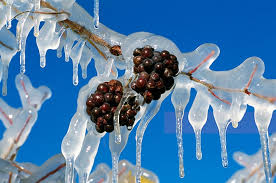 “En la pequeña ciudad canadiense de Beamsville, a unos 40 kilómetros al oeste de las cataratas del Niágara, un grupito de siluetas agachadas se mueve en una viña iluminada por la luna en una gélida noche de enero. Están recogiendo su cosecha de uvas, totalmente heladas, de Gewürztraminer. Con un cielo estrellado, y cristales de hielo brillando en el aire, la temperatura ha caído a -10º C: son las condiciones ideales para la recogida de fruta con la que se elaborará el 'icewine', el vino de hielo de esta añada.” Es probable que en alguna ocasión hayas escuchado hablar del vino de hielo. Es por ello que voy a dedicar el presente artículo a este singular producto, explicando su origen, evolución y, sobre todo, la diferencia entre vino de hielo y vino de «congelador». A comienzos del siglo XVIII, cuando Louis XV le ofreció a Madame de Pompadour una copa de vino dulce de Tokaj, el monarca se refirió a éste como “Vino de Reyes, rey de los vinos” y es que el pobre no tuvo tiempo de probarlo…De haber sido así, hubiera tenido seria competencia con este elixir de hielo. El vino de hielo, escaso, raro, especial, poco conocido, el eiswein, es uno de eso vinos mágicos…Es un vino dulce elaborado con uvas congeladas de forma natural en la viña. El momento y condiciones de su cosecha así como las zonas donde se obtienen es lo que lo hacen especial. Existen vinos de hielo blancos, rosados, tintos y hasta sidra. Son vinos sabrosos, de aromas profundos y dulces, pero suaves y de una acidez intensa. Denominado en inglés ice wine y en francés vin de glace, usa la técnica de sobremaduración de la uva en la cepa hasta que se produce las heladas. Las uvas con las que se elaboran son generalmente blancas, tales como Riesling, Vidal (híbrido) prohibido en Europa, pero popular en Canadá— o Gewürztraminer, aunque también las hay tintas, como Pinot Noir o Cabernet Sauvignon. Los vinos de hielo no dependen de una variedad de uva concreta, sino de un tipo de viticultura y vinificación. Las uvas deben ser vendimiadas a mano en estado de congelación en el racimo y prensadas con los cristales de hielo, lo que provoca una alta concentración de azúcares y ácidos debido a la deshidratación, mejorándose de este modo la extracción de compuestos aromáticos. A principios de agosto se selecciona la uva e incluso se meten los racimos en bolsas de papel (similares a los de la uva del Vinalopó) para preservarlos y que maduren más despacio ya que así el sol no incide tan directamente. Es un vino que se trabaja siempre con la incertidumbre de si helará lo suficiente para poder vendimiar ya que hay que obtener una uva concentrada, muy madura que tardará en fermentar. 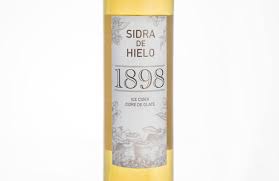 Por otro lado, este tipo de vino se obtiene en regiones frías de países con bajas temperaturas. Se elaboran vinos de hielo en Canadá –que es el mayor productor mundial-, Estados Unidos, Alemania, Austria, Suiza y Luxemburgo. En España se han elaborado con éxito vinos de hielo en Rueda, con la variedad Verdejo, en la Rioja, Palencia…entre otras , con variedades tintas Tempranillo y Garnacha. En la actualidad la Unión Europea reconoce que un vino de hielo puede considerarse así cuando emplean uvas heladas o que lo estaban en la cepa en el momento de la recolección y prensado. Se precisa que todas las uvas procedan de una misma región reconocida. Su dificultad y escasez, debido a que no todos los productores están dispuestos a realizar este tipo de vino y que tienen que darse unas condiciones climáticas muy concretas (no todos los años es posible elaborar estos vinos), justifican su elevado precio en mercado, que han convertido a este tipo de vinos en auténticas "joyas enológicas", según muchos autores. La 'crioextracción' o extracción en frío, es un proceso por el cual las uvas son artificialmente congeladas y prensadas, generalmente con la intención de elaborar vinos de hielo de manera artificial. Mediante este sistema se obtienen vinos blancos dulces o semidulces, aunque cada vez más se emplee este sistema en la producción de vinos blancos secos y aromáticos. Los enólogos intentan recrear las mismas condiciones naturales que se dan en la elaboración de los auténticos vinos de hielo. Uvas seleccionadas se someten a temperaturas bajo cero (-6° ó -7°C), para ser prensadas cuando todavía están congeladas. Aunque es una técnica enológica muy utilizada que da como resultado vinos muy interesantes, la Unión Europea no permite denominarlos "vinos de hielo" ya que las uvas han sido heladas por métodos artificiales. También existe curiosamente la “La sidra de hielo”. En España es famosa la asturiana y remite, por ejemplo, a lo que les pasaba a los alemanes con la uva de hacer vino o a los canadienses, que se les congelaban las manzanas de hacer sidra esperando una maduración propicia para un contenido alto de azúcar y/o de alcohol. De la necesidad, virtud: al prensar la fruta congelada se pierde agua y el mosto resulta más concentrado. El procedimiento ya lo aplicaba algún elaborador de sidra de Asturias y la D.O lo admitió no hace mucho. Luego, lo ha incorporado El Gaitero ,dispuesto a abanderar la renovación de ese producto más allá de su sidra achampañada, y al resultado le llama 1898, que es el año al que se remonta su bodega. Esta sidra de hielo asturiana es un elixir frutalmente maduro y dulce, pero las notas de limón o mandarina , junto a las de manzana asada— y una fresca acidez hacen que no resulte empalagoso. Pasa tres meses en barrica. ¿Con qué nos lo bebemos? Es un vino que se disfruta mucho por sí solo, despacito, a besos, como me gusta llamarlo a mí, conversando con él lentamente y con atención. Sobre todo los canadienses son vinos muy fáciles de disfrutar, expresivos y francos desde el primer momento. Los alemanes suelen necesitar algo más de tiempo, tanto de crianza en botella como recién servidos en copa. Algunos vinos de hielo alemanes agradecen incluso la decantación. Me gusta como aperitivo, ya que la alta acidez nos hace salivar y la saliva prepara el estómago para la digestión. Genial con cualquier tipo de foie-gras, caliente o frío, y maravilloso con casi cualquier tipo de queso. Si lo acompañamos con postres, lo ideal es que el postre no sea más dulce que el vino, así que genial con cualquier tipo de fruta. Con chocolate negro, mejor los vinos de hielo tintos (aunque generalmente son rosados a la vista). Para los más atrevidos paladares, marida muy bien con escabeches: el de uva Vidal con pato a la naranja y con la comida asiática algo picante, sobre todo con la Thai. El de Pinot Noir se recomienda pareja con unos lomos de venado. Su origen: El origen de estos vinos se remonta al siglo XVIII en la región de Franconia (norte de la Baviera Alemana). Por unas circunstancias de necesidad al haberse helado las uvas y al no querer resignarse los viticultores a perder la cosecha, decidieron probar el aprovechamiento de lo que pudieran de las uvas congeladas, consiguiendo un apreciadísimo vino de mucho cuerpo y muy dulce que agradaba a quién lo probaba y fue un absoluto éxito, lo que les obligó a persistir posteriormente en el sistema. No obstante se perdían grandes cantidades de uva en aquella época por los grandes problemas de fermentación. También cuentan que... En Dromesheim, en la región vinícola de Rheinhessen, (sudoeste de Alemania) sí existe más documentación sobre una cosecha de 1829, lo cual le ha servido a las bodegas de la zona para exhibir orgullosas una escultura conmemorativa con la leyenda «Dromesheim, lugar de nacimiento del Vino de Hielo», algo que al parecer no les corresponde, pero así son las cosas. En aquel durísimo invierno de 1829 el forraje para los animales escaseaba y muchos propietarios de viñedos decidieron dejar las uvas en la viña para alimentar al ganado durante el invierno… Hasta que alguno probó una uva y, sorprendiéndose del dulzor y acidez que contenían, decidieron prensar y elaborar el vino. Irene Sayas 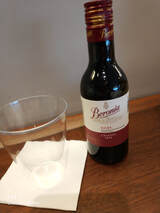 My Encounters with Wine, moves to the cafeteria car of the train. It is an idea that haunted my head for a while and at the suggestion of a great friend, so this time and taking advantage of a tedious and endless train ride for family visit, I got to it...After riding five cars from my seat, I arrived at the cafeteria car-bar. I asked about the availability of wines, my surprise was that they only had red, in Benjamin format bottle, which is equivalent 1/4 to standard bottle. I could not choose, was Beronia crianza 2016, with D. O. Rioja. I asked for white wine and they were out of stock. Its price, 3.60 euros.  It seems that Renfe, at least on long-distance trains like this Talgo, does not bet, not cares for the subject of catering service, nor many others... I proceed to the opening of a screw-cap and serve it in a plastic glass. Its colour surprises me, because its garnet-clean with a fairly high robe was not within my expectations. I accompanied it with a triple sandwich, half vegetable and half mixed, which I appreciated, because the temperature of the wine along with the plastic, caused a twinge in my stomach. With aromas, I managed to get nothing but the aging of the wine, sorry, and on the palate, structured and (background)high-roast) In this case, the meaning and origin of the word CATA (tasting), which comes from Latin captare, which means to,” to grab”, just set me up! Since the rattle of the train, it forces you to do it... hahaha This has been my humble and optimistic version of events. I encourage you to taste our excellent broths in different means of transport, perhaps, a demand for it, would give us more alternatives! CURIOSITIES: I'll talk a little about the aroma of coffee or roasted in wine : The legend of the origin of coffee is curiously reminiscent of that of wine, Some Yemeni monks would have verified an unusual excitement among their goats and they would have noticed that they ate the fruits of an unknown shrub, so the monks tasted these fruits... The Jewish legends say that Noah would have discovered the wine in the same way and its effects, observing the strange behavior of a goat intoxicated by fermented grapes. Coffee is probably native to Ethiopia but its cultivation spread throughout numerous tropical and equatorial countries, especially Central and South America. The aroma of coffee comprises more than 850 components, among which furfurfurilmercaptan (Furan-2-ilmetanotiol is an organic compound containing a furan substituted with a sulfanymethyl group. It is a clear, colourless liquid when pure, but turns yellow when standing for a long time. It has a strong smell of roasted coffee and a bitter taste) has an important role. This scent of wine resembles, like cocoa, all the nuances called roasting and its presence seems similarly linked to the aging in new barrels and the warming that they undergo during the willow ... OBSERVATIONS: It is not the same to drink a glass wine in a high-end glass than to make it in a plastic glass ... To realize it is not necessary to be understood or stretched ... simply do a simple test, pouring the liquid in two different cup formats, you'll see that even the water knows otherwise. With wine, a liquid element full of aromas and flavours that you want to enjoy, it happens the same, so the glass takes on special importance if what you like is not just drinking the wine, but enjoying it. These should be the correct characteristics of a good glass: Transparency. The glass has to be neutral, not distort colours that we may want to appreciate, especially if we drink rosés or wines with years of aging in the bottle. The shape is the most important after the material, which preferably has to be glass, since according to the silhouette of the glass, aromas can be concentrated better than others. For example, narrow glasses, usually, are not good for poking your nose and start perceiving fruit or spices. Depending on the shape of the cup and especially its upper part, its opening, it will "throw" the wine to one part or another of the mouth, and depending on that "geographical" area, you will be able to perceive the sweet, the bitter, the saline ... A narrower cup, for example, throws the wine to the tip of the tongue, stimulating the sweet perception. If it is wider, the liquid goes further back and excites other areas and different taste buds. 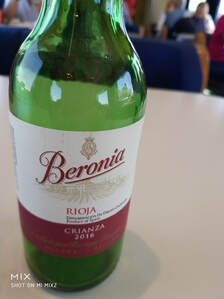 Mis Encuentros con el Vino, se desplaza al vagón cafetería del tren. Es una idea que rondaba mi cabecita desde hace un tiempo y por sugerencia de una gran amiga, así que en esta ocasión y aprovechando un tedioso e interminable viaje en tren para visita familiar, me puse a ello…Tras recorrer cinco vagones a duras penas desde mi asiento, llegué a la barra del vagón cafetería. Pregunté por la disponibilidad de vinos, mi sorpresa fue que solamente tenían tinto, en botella de formato Benjamín, que equivale a ¼ de botella estándar. No pude elegir, era Beronia crianza de 2016, con D. O. Rioja. Pregunté por vino blanco y no tenían existencias. Su precio/ botellita es de 3,60€. Parece que Renfe, por lo menos en trenes de largo recorrido como este Talgo, no apuesta, ni cuida el tema de servicio de restauración, ni muchos otros… Procedo a la apertura de tapón de rosca y me lo sirvo en un vaso de plástico. Su color me sorprende, pues su granate-limpio con una capa bastante alta, no estaba dentro de mis expectativas. Lo acompañé con un sándwich triple, mitad vegetal y mitad mixto, cosa que agradecí, pues la temperatura del vino junto con el plástico, causó una punzada en mi estómago. De aromas, no conseguí sacar nada más que la crianza del vino, lo siento, y en paladar, percibí que estaba bien estructurado y un fondo torrefacto. En este caso, el significado y origen de la palabra CATA, que viene del latín captare, que significa «coger, agarrar», no puede venir más a huevo! Ya que el traqueteo del tren, te obliga a ello...jejeje. Esta ha sido mi humilde y optimista versión de los hechos. Os animo a poder saborear nuestros excelentes caldos en diferentes medios de transporte, quizá así, una demanda de ello, nos daría más alternativas! CURIOSIDADES : Hablaré un poco del aroma a café o torrefacto en el vino : La leyenda del origen del café recuerda curiosamente a la del vino. Unos monjes yemenitas habrían constatado una excitación inhabitual entre sus cabras y se habrían dado cuenta de que comían los frutos de un arbusto desconocido, entonces ellos probaron estos frutos... Las leyendas judías cuentan que Noé habría descubierto de la misma manera el vino y sus efectos, observando el extraño comportamiento de una cabra embriagada por unas uvas fermentadas. El café es probablemente originario de Etiopía pero su cultivo se extendió por numerosos países tropicales y ecuatoriales, especialmente América Central y América del Sur. El aroma del café comprende más de 850 componentes, entre los cuales el furfurilmercaptan (Furan-2-ilmetanotiol es un compuesto orgánico que contiene un furano sustituido con un grupo sulfanilmetilo. Es un líquido transparente e incoloro cuando está puro, pero se vuelve de color amarillo al permanecer de pie por un tiempo prolongado. Posee un fuerte olor a café tostado y un sabor amargo) tiene un papel importante. Ese perfume del vino se parece, como el cacao, a todos los matices llamados de torrefacción y su presencia parece igualmente ligada a la crianza en barricas nuevas y al calentamiento que sufren durante el cimbreo... OBSERVACIONES :
No es lo mismo tomarse un vino en una copa de cristal de alta gama que hacerlo en un vaso de plástico... Para darse cuenta no hace falta ser un entendido o u estirado...simplemente haz una prueba sencilla, vertiendo el liquido en dos formatos de copa diferentes, verás que hasta el agua sabe de otra forma. Con el vino, un elemento líquido cargado de aromas y sabores que apetece disfrutar, pasa igual, por lo que la copa cobra una especial importancia si a ti lo que te gusta no es solo beberte el vino, sino disfrutarlo. Estas deberían ser las características correctas de una buena copa : Transparencia. El cristal tiene que ser neutro, no distorsionar colores que nos puede apetecer apreciar, sobre todo si bebemos rosados o vinos con años de crianza en botella. La forma es lo más importante después del material, que preferiblemente ha de ser cristal, ya que según la silueta de la copa, se pueden concentrar unos aromas mejor que otros. Por ejemplo, copas estrechas, por lo general, no son buenas para meter la nariz y empezar a percibir fruta o especias. Según sea la forma de la copa y sobre todo su parte superior, su abertura, ésta “lanzará” el vino a una parte u otra de la boca, y según sea esa zona “geográfica”, podrás percibir antes el dulce, el amargo, el salino… Una copa más estrecha, por ejemplo, lanza el vino a la punta de la lengua, estimulando la percepción dulce. Si es más ancha, el líquido va más atrás y excita otras zonas y papilas gustativas distintas.  7 VIN Blau & Zwei 2015 Organic and biodynamic limited release brand red wine, made with the Austrian varieties Blaufraenkisch 50% and Zweilgt 50%. Aged with 13 months in French and American oak barrels, removing the lees for the first 4 months. Kieninger Winery. Partida Rural Los Frontones. Ronda (Malaga). D.O. Sierras de Málaga. TERROIR: The soil of the vineyard is loamy, clayey-calcareous with enough sand to have a good drainage function. At 800 meters high. Orientation South-East. Located at gentle slopes, protected from the North. The place is surrounded by centenary oaks, maroons, blackberries, quinces and hawthorn. The treatments of the plants in the vineyard are done through biological means and maturation is carried out in a cellar in stone and underground, following the traditional style of natural fermentation. TASTING: The first pleasant surprise has been the uncorking, as I find a quality cork, hyper-perfumed and elegantly signed. When serving the glasses, strikes me by the colour of its foam, very tinged to be aged and a beautiful crimson colour, I imagine it is characteristic of these grapes... I decide to skip the first phase, the visual and after having awakened the wine, we analyze its aroma and palate after being so long stored and thus get retronasal before the seduction of rest disappears. A touch of acidity clearly appears, which evaporates when pairing. Spiced hints: black pepper and some nutmeg. Cocoa and the woody part of the grape cluster coming through. On the palate, cassis, a touch of green pepper, graphite and truffle. Very high robe and subtle presence of tears. Sinuous and curvy wine. Original and noble wine. We accompany it with different delicacies, and we agree that the duck confit praises him, opens and maintains the aftertaste of this wine, the grilled aubergine with some truffle shavings and the French potatoes with mojo picón sauce, also enhance its flavour and yet a smoked sheep cheese transforms it... As this wine offers me walks and evolutions... for its musical pairing I bet on Modest Mussorgsky's "Pictures of an Orchestra Exhibition". CURIOSITIES: Being an unprecedented wine for the good adaptation of these Austrian grapes in the Serranía de Ronda, tell you a little about them... The red grape Blaufränkisch is a variety of dark-skinned, late-ripened grapes. It produces wines that are normally rich in tannins and can exhibit a pronounced spicy character. It has the elegance of Pinot Noir, tannic as Nebbiolo and spiced like Syrah. For a long time it has been mistaken with Gamay, although no one has been able to demonstrate a degree of relationship between both. In Germany, this grape is known as Lemberger and in Hungary as Kékfrankos. The Blaufränkisch is the mother of Zweigelt, the most planted red grape variety in Austria, the result of a cross of this with the Saint Laurent. Austrian winemaking is promoted by the Cistercian Monks (so well known in Burgundy, Tuscany and Priorato). Already in the twelfth century some special vineyards for their terroirs stood out in monasteries and abbeys. The 7 VIN, with D.O. Sierras de Málaga is produced in a winery located in the Serranía de Ronda, but it cannot carry its name, since 100% of the grapes from this subzone must be used for its production, and must also meet other specific requirements. LEGEND: Legend has it that on St. Martin's Day, the "new wine" arrives ripe to delight the followers of the Heurigen of the area. After its short winemaking process, from the must, through its important fermentation step, this vibrant and almost brand new young wine lends itself to entertaining thousands of palates. There is also the so-called "Gemischter Satz" which is a blend of white grapes, almost always from Riesling, Gruner Veltliner or Weiss Burgunder. HEURIGEN are wine taverns where young wines are tasted. These taverns were founded by imperial resolution, in August 1789, and it is where every year the new wine is welcomed (Nouveau, Novello, Vineta as you want to call it) from the day of St. Martin (November 11 to December 31). In the Heurigen you can also try the typical dishes of Austrian gastronomy. Knowing a little more about these berries, their origins and customs, I dare say that it has been a good and risky choice by Martin Kieninger, and grateful to be able to taste this annexation.
To enjoy the wine you don't have to be an expert, but the more we learn from something, the more we enjoy it, right? Through TASTING IN ESSENCE we try to create a conductive thread between the essences of wine and people. "The essence is invariable and permanent and constitutes the nature of things. It is a notion that refers to the characteristic and most important of one thing. The essence is the persistent reality, it will remain intact. The term comes from Latin, which in turn derives from a Greek concept". (bibliographic source) It is also called essence to the concentrated liquid extract of a substance, generally aromatic. The essences can be also perfumes or aromatic substances.  Did you know that the most powerful sense man has for tasting, is smell? Wine is a true aromatic microcosm. The essence of wine is born in the vineyard and in its transformation. In the tasting I always look for the character of the wine according to its profiles terroirs, chromatic, aromatic and taste, emphasizing the evolution and final in mouth. Different wines are compared with their certain accompaniments, I mean pairing, which includes doing it with music too, because I do not conceive the tasting without it... Wines are tested carefully, appreciated and subjected to our senses, in order to achieve satisfaction. Stimulation = organ of the senses = feeling (reflection) = perception (phonetic expression) The wine contains more than 500 chemical substances that when they are in appreciable doses for the human being, stimulate us and reach the brain that evaluates and synthesizes them to compare with previous memories with which it is associated.When the brain recognizes the stimulus caused by the characteristics of the wine, it produces what is called perception: the stimulus becomes an interpretation. Wine tells us many stories and from many perspectives. Some have made reference to the vineyard and its cultivation. Others speak of their origin, of their legends and of the way in which the wine was incorporated into our lives. Sip by sip, discover its mysteries, its myths, its aromas, its perfume, its emotion, its origin, generate inspiration, inhale art, feel that evokes us, and that provokes us, like a painting to contemplate it.
A captivating journey through the culture of wine and its many aspects. A different, exclusive and unforgettable way to fall in love with wine. My Encounters with Wine Mailblog/Tastings Irene Sayas |
irene sayasEntusiasta y conocedora de la magia del vino. El vino evoca, convoca y provoca... *Archivos:
|
Cómo contactarnos / How to contact usTeléfono 690 073 871 |
Suscribirse / SubscribeÚnete a nuestra lista de correo hoy!
Sign up to our mailing list now! |

